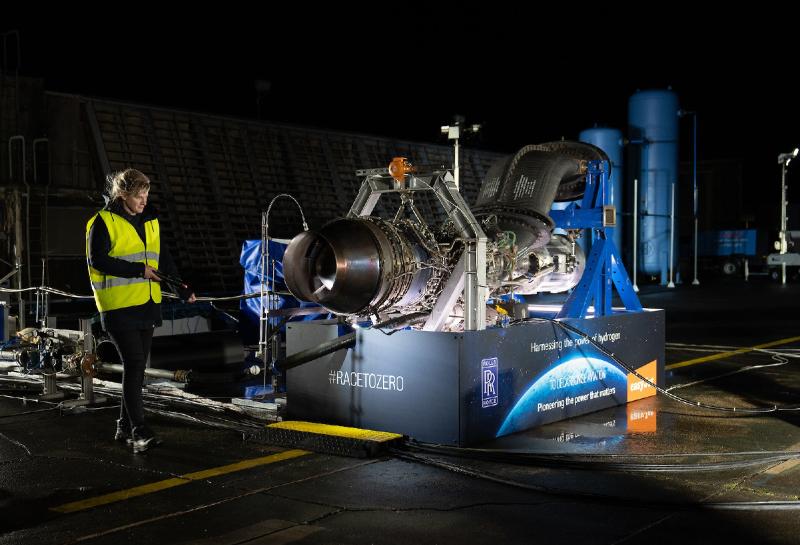Airplane engine burns hydrogen during a ground test
By: Harry Guinness (Popular Science)


Hydrogen worked for Artemis, didn't it? The problem these tests are trying to address is retro-fitting an alternative fuel to the existing fleet of aircraft engines. There are also tests to use ammonia as an alternate fuel in existing engines. These alternative fuels may require switching to engines specifically designed for the fuel. Obviously the aviation industry wants to avoid that because the cost to change out engines would be astronomical.
One of the canards always included to argue against hydrogen is lower energy density. But that's only true by volume and not be weight. Pound for pound, hydrogen is three times more energy dense than gasoline. That's why the Artemis rocket utilizes liquid hydrogen rather than a fossil fuel. In rocketry, weight matters.

British airplane engine maker Rolls-Royce and low-cost airline easyJet announced this week that they had successfully powered a modern airplane engine using 100% hydrogen fuel. The test took place at a military facility in the UK, with the engine remaining stationary on the ground.
Since the aviation industry currently produces about 2% of global carbon emissions, there are serious reasons to develop a greener way to fuel planes. Rolls-Royce (the aerospace and defense contractor, not the similarly named car brand that is owned by BMW) is hoping that hydrogen might hold the answers it needs to keep selling its turbofans and other engines into the future.
Most airplane engines run on jet fuel, which is based on kerosene. Unfortunately for the climate, that's a fossil fuel that releases CO2 when burned. Some airlines mix in sustainable aviation fuels (SAFs) that are chemically identical to kerosene, though are manufactured from renewable starting materials like used cooking oil, food scraps, and corn stover (the remains of corn cobs after the harvest). Still, because SAFs are chemically the same as kerosene, they release just as much CO2 when they are burned—the benefits are just that the processes required to manufacture them may be more environmentally sustainable.
Hydrogen offers a potentially better option as it contains no carbon. When it's burned, the main byproduct is water vapor (though there are still some pollutants like nitrous oxide). As long as the hydrogen is produced using wind, wave, or other renewable forms of electricity, it can legitimately be a carbon-neutral fuel. For this test, Rolls-Royce used "green hydrogen" from the European Marine Energy Centre in the Orkney Islands. It was produced using tidal energy, rather than reconstituted from methane gas.
Hydrogen can potentially power planes in two different ways: As the fuel source for an electricity generating fuel cell that powers an electric motor, or by being directly burned. Rolls-Royce and easyJet took the second approach using a Rolls-Royce AE 2100-A regional aircraft engine that had been modified to burn hydrogen instead of jet fuel. Given the success of this test, they plan to work up to a full-scale ground test using a Rolls-Royce Pearl 15 jet engine and eventually a flight test using civil aero engines.
Of course, hydrogen comes with its own host of problems. It is significantly less energy dense than kerosene, so aircraft would have to carry larger amounts of fuel to cover the same distance. It's also a gas at temperatures above −423°F (−253°C), which makes storing it more challenging. For Rolls-Royce's test engine, it was compressed to 200 bar (roughly 100 times the typical tire pressure of a car). This makes it significantly more viable for short haul flights, rather than trans-oceanic and other long haul routes.
Still, there are promising signs that hydrogen could have a future in the world of aviation—especially as the industry strives to be carbon neutral by 2050. Johan Lundgren, the CEO of easyJet, called it "a huge step forward" in the press release. Similarly, Grazia Vittadini, the Chief Technology Officer of Rolls-Royce, said, "The success of this hydrogen test is an exciting milestone… We are pushing the boundaries to discover the zero carbon possibilities of hydrogen, which could help reshape the future of flight."
Rolls-Royce isn't the only aerospace company exploring hydrogen as an option. Airbus has plans to get an A380 in the air with a hydrogen engine by 2026. The European Union hopes that by 2035, short-range flights would be possible, and that by 2050 up to 40 percent of flights in Europe would be powered by hydrogen.
But make no mistake: No matter how successful Rolls-Royce and easyJet's tests are, we are still a long way from large numbers of hydrogen-powered jets taking to the skies.




If people want to fly high and fast, hydrogen is the obvious choice of fuel. But hydrogen may not be practical for the existing fleet of aircraft that were designed to burn fossil fuels.